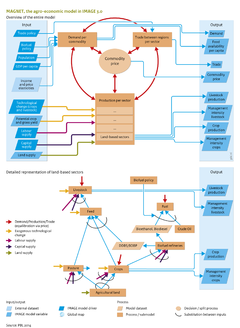Agricultural economy/Description: Difference between revisions
Jump to navigation
Jump to search
ElkeStehfest (talk | contribs) No edit summary |
ElkeStehfest (talk | contribs) No edit summary |
||
| Line 12: | Line 12: | ||
===Land use=== | ===Land use=== | ||
In addition to the standard GTAP model, MAGNET includes a dynamic land supply function ([[Van Meijl et al., 2006]] that accounts for the availability and suitability of land for agricultural use, based on information from IMAGE (see below, and figure on the right). A nested land-use structure accounts for the different degrees of substitutability between types of land use ([[Huang et al., 2004]]; [[Van Meijl et al., 2006]]). In addition, the MAGNET model includes international and EU agricultural policies, such as production quota and export\import tariffs ([[Helming et al., 2010]]. | In addition to the standard GTAP model, MAGNET includes a dynamic land supply function ([[Van Meijl et al., 2006]]) that accounts for the availability and suitability of land for agricultural use, based on information from IMAGE (see below, and figure on the right). A nested land-use structure accounts for the different degrees of substitutability between types of land use ([[Huang et al., 2004]]; [[Van Meijl et al., 2006]]). In addition, the MAGNET model includes international and EU agricultural policies, such as production quota and export\import tariffs ([[Helming et al., 2010]]). | ||
===Biofuel crops=== | ===Biofuel crops=== | ||
MAGNET includes ethanol and biodiesel as first-generation biofuels made from wheat, sugar cane, maize, and oilseeds [[Banse et al., 2008]], and the use of by-products (DDGS, oilcakes) from biofuel production in the livestock sector. | MAGNET includes ethanol and biodiesel as first-generation biofuels made from wheat, sugar cane, maize, and oilseeds ([[Banse et al., 2008]]), and the use of by-products (DDGS, oilcakes) from biofuel production in the livestock sector. | ||
===Livestock=== | ===Livestock=== | ||
Revision as of 17:14, 5 December 2013
Parts of Agricultural economy/Description
| Component is implemented in: |
|
| Related IMAGE components |
| Projects/Applications |
| Key publications |
| References |
